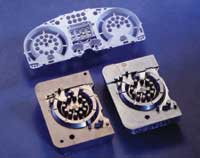WEB EXCLUSIVE: DMLS tools on the rise
Vaupell Molding and Tooling (Seattle, WA), one of the world’s leading molders for aerospace and medical markets, recently chose to add a direct metal laser-sintering system (DMLS) to produce tooling inserts, prototype parts, and metal end products at its Rapid Solutions division. Vaupell, with $76 million in annual sales and facilities around the globe, is not alone in its enthusiasm for DMLS.
June 1, 2008
Vaupell Molding and Tooling (Seattle, WA), one of the world’s leading molders for aerospace and medical markets, recently chose to add a direct metal laser-sintering system (DMLS) to produce tooling inserts, prototype parts, and metal end products at its Rapid Solutions division. Vaupell, with $76 million in annual sales and facilities around the globe, is not alone in its enthusiasm for DMLS.
|
According to Mike Shellabear, vice president at EOS GmbH (Munich, Germany), Vaupell’s decision to use an EOSINT M270 DMLS system illustrates a trend among toolmakers, prototyping bureaus, and progressive molders toward adoption of the technology. “As soon as you have geometry that needs EDM or undercuts,” says Shellabear, “there are a number of advantages to laser sintering. With production tooling inserts, for example, users can integrate conformal cooling to reduce cycle times. For prototype tools, where cycle times are not critical, DMLS provides a time advantage, typically turning out molds in about half the time required for traditional prototype tools.”
Another technique becoming more common, he explains, is called the ‘onsert’ method. “We’ve heard the term used by some of our customers. Rather than building mold inserts via DMLS, and then inserting them into a mold frame, they are building up the mold cavity shapes directly on a base plate using the same equipment. It is more efficient because there is no need to cut a hole and bolt the insert onto the plate.”
Cost savings reported by customers range from 25-50%, according to EOS. “Typically, as complexity goes up, so does the savings, which refer to the mold production as well as the molding itself. Using conformal cooling and tool optimization, for instance, molders may be able to increase the cavitation and use only one mold instead of two.”
Cycle time reductions are said to range from 10-65%.
Shellabear confirms that DMLS is still a relatively young technology, and has at times been confused in the U.S. with the earlier indirect sintering technology. That method included metal powder with a plastic binder, required post sintering and metal infiltration, and was plagued by inaccuracies and warpage, according to Shellabear. “Once moldmakers found out that our process was producing metal tools directly, the interest level began to grow and continues to do so.”
About the Author(s)
You May Also Like



